SELECTING AND USING A LIGHT WITH A LONG GUN
It is absolutely critical that a shooter knows what he or she is shooting. Whether a paper target on the range or a person who is attacking you, it is vitally important that you know who or what you intend to shoot. After all, unless you are crazy, you don’t want to shoot someone or something unjustifiably.
And to positively know who or what the target is, you have to be able to see it clearly enough to identify it. So, there must be enough light to do so. Since it is a fact that most deadly force encounters happen in dim light where it is hard to see, having a light source you can use to illuminate your target is essential. And there are options that include a light that is mounted on the gun or a light that is handheld. Then there are different handheld and weapon-mounted lights to choose from. Once a light is chosen, you need to know how to use it safely and effectively.
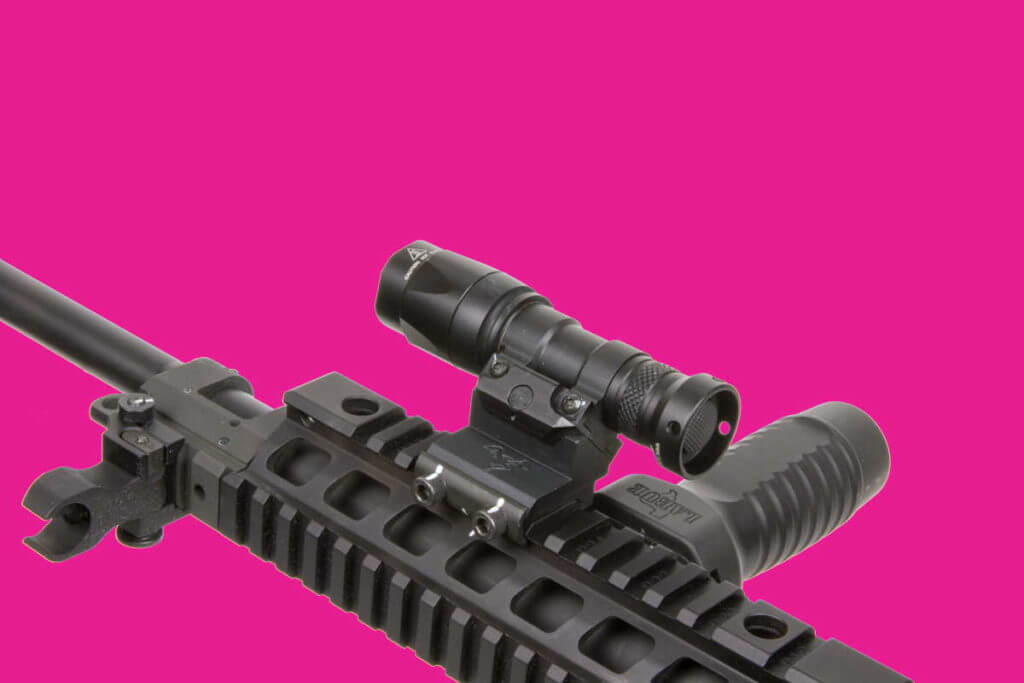
That’s a lot of things to consider. While there are other options besides those mentioned here and in another The What & The Why article about handguns, this article will concentrate on some of the options for long guns.
Law enforcement and the military recognize that a long gun is a more effective tool for self-defense than is a handgun, and both make wide use of lights with those long guns. But as a regular, non-sworn citizen, you may also have need for a light if you use a long gun for defense.
Why is it important to identify a potential threat in your own house before shooting? If you are startled awake, you don’t want to shoot your spouse who is up in the middle of the night to get a drink of water, do you? Or what if a neighbor comes into your house after a long night of drinking, thinking it is his house? These things happen.
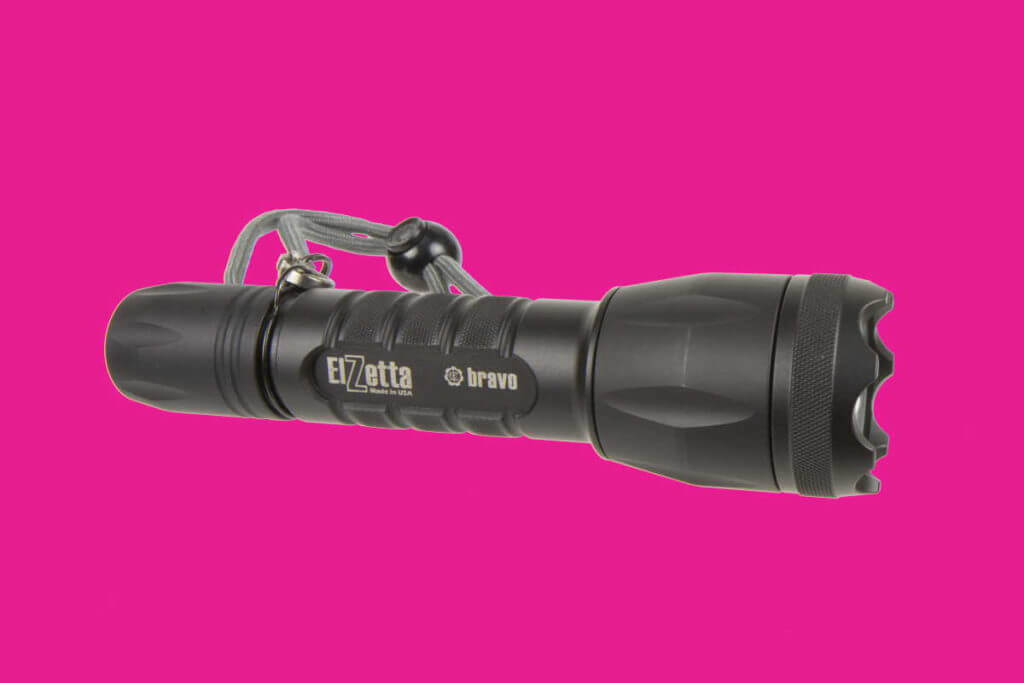
There are many reasons to have adequate light to identify a potential threat besides being able to see it well enough to hit it. And as mentioned above, there are options for lights. A light mounted on the gun is easier to manipulate, and it is easier to control, aim, and shoot the gun if the light is on the gun and doesn’t have to be held in one hand while the other shoots the gun. But, whether or not the light is mounted on the gun or held in the hand, things like switching, weight, and power source are considerations. And how and where on the gun the light may be mounted also need to be considered.
As mentioned in the other The What & The Why article about lights and handguns, probably the best place to start the selection process is determining what your mission is – or what you intend to do with the light and the gun. Elzetta, a maker of very high-quality tactical lights, suggests first deciding how far away likely threats may be. Then select a light that has a range specification that is double that distance. That’s because light intensity falls off rapidly with distance.
Also, consider whether or not the light beam has any dark spots in it which can allow a threat to go unnoticed. Another thing to consider is the width of the light beam. SureFire’s approach to this problem is to focus the beam enough that the light will travel a certain distance and also have a “soft edge” so that the light is still intense enough near the edges of the beam to allow the user’s peripheral vision to work. If the edge of the beam is sharp and there is no “spill” light around the edges, people tend to focus solely on the things well lighted in the center of the beam and may not see a threat that is lurking in the shadows off to the side.
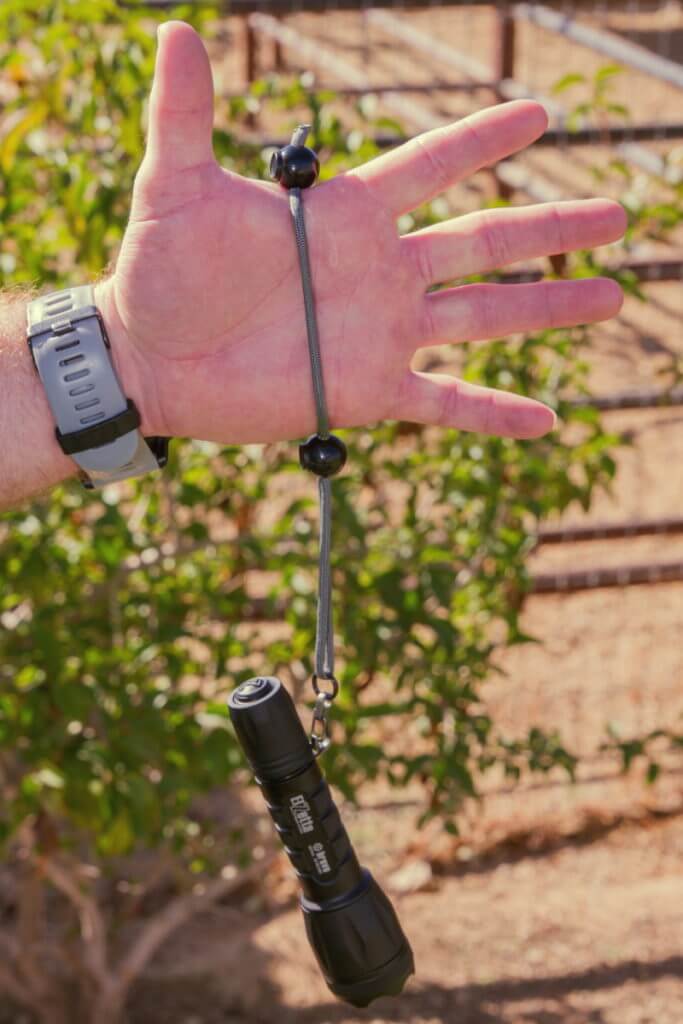
Even a very sharp narrow beam can be used inside a structure if the walls and ceiling are close enough for light to bounce off them and illuminate a whole room or large area. If your use is anticipated to be inside your house, then any light that has a minimum of 50 lumens – that’s what SureFire says is the minimum needed to “blind” a person who has night-adapted vision – might be adequate for your needs. But that is for you to decide.
If on the other hand, you anticipate that you will use the light outside where there may be almost no, or absolutely no, ambient light, you might need a light with a beam that will reach farther. Or you may opt for a light that spreads the beam over a wide area to maximize your use of peripheral vision. No one can decide these things for you. You must decide what is important for yourself. The salesperson behind the counter may not have your best interest at heart.
And here is a word of caution. If you mount a light on your long gun’s fore-end or handguard and you anticipate using that light for searching outside when it is very dark, think about shadows that may be the result of where the light is mounted.
For example, I was once training at Gunsite Academy at night. Students were performing solo searches with AR-15s outside, and this night, there was absolutely no light. It was pitch black. I had a SureFire Scout weapon light mounted on the right side of the handguard, behind the muzzle. As a result, the light cast a black shadow caused by the barrel on the left side of the gun. A whole infantry platoon could be “hidden” by the shadow, and I would not have seen it.
My solution was to consider where any shadows might fall. Since it was not likely that a threat would present itself from above, I moved the light mount down a few inches so the light attaches in the same place as before but at 45 degrees below and to the right of the barrel. Then any shadows cast would be at a 45-degree angle to the left and above the barrel, where a threat would be less likely to be. Those readers who are SWAT operators and could find yourself in a similar situation should take special note.
As mentioned earlier, besides the power source – I will never buy another Duracell product because the claim process was very difficult after an AA alkaline battery leaked and damaged a very expensive piece of equipment – weight, and switching method are important to consider when selecting a light. Weight could be a problem – or maybe not. The switching mechanism should be carefully considered though. Generally, a simple on and off switch is the best solution for a light that might be used in a life and death situation. A switch that does more than turn the light on or off and that controls functions of the light – like intensity or a strobe – makes using the switch under stress confusing and slow.
So, most people who use a light for serious work, prefer a simple on and off switch. If the light has other modes, it should be controlled by a different switch so that it can be manipulated during a period when time is not limited and stress is lower. And most operators prefer a light without a strobe feature because they find it not necessary. A strobe may disorient an attacker, but it can also disorient a user. Besides, if a strobe is really needed, a simple switch can be pressed on and off rapidly to create the same effect.
As mentioned earlier, a weapon-mounted light has the advantage of allowing the user to manipulate the gun and handle it with both hands. Sure, if a handheld light is used, it is more difficult to shoot the gun. But when a handheld light is used in conjunction with a weapon-mounted light, the handheld light can be a backup in case the weapon light malfunctions. And if the handheld light is used for searching or lighting an object, the gun on which a weapon light is mounted is not pointed at whatever the light is pointed at. It’s a safety consideration.
If the light is mounted on the gun, it is best if the switch is located somewhere so that manipulating it does not require a hand be moved away from its normal shooting position. It is simply faster to manipulate a light switch and shoot a gun at the same time if both hands remain in that normal shooting position. So, most experienced shooters prefer a switch that is located where moving the hand is not required. Sometimes the light is positioned where a finger of the hand in a normal firing position can simply push a button or a tape pressure switch connected to the light. Often that is somewhere on the handguard or fore-end.
When a handheld light is used with a long gun, one of several techniques can be used. Some, but not all, are discussed here. To learn more of them and how to perform them properly, good training from a place like Gunsite Academy is essential. In a well-run class, you will have the opportunity to shoot a gun in low light, learn how to shoot and manipulate a light at the same time, and be able to practice those skills repeatedly. You can’t learn to do these things by reading this article, or any other article, or watching a video.
One method of manipulating a handheld light while using a long gun, is the lite touch method. To use it, the long gun must have a magazine or magazine well that protrudes from the bottom of the gun. The light is held in the support hand and pressed back into the well or the magazine to activate it. It requires a light with a switch at the back though.
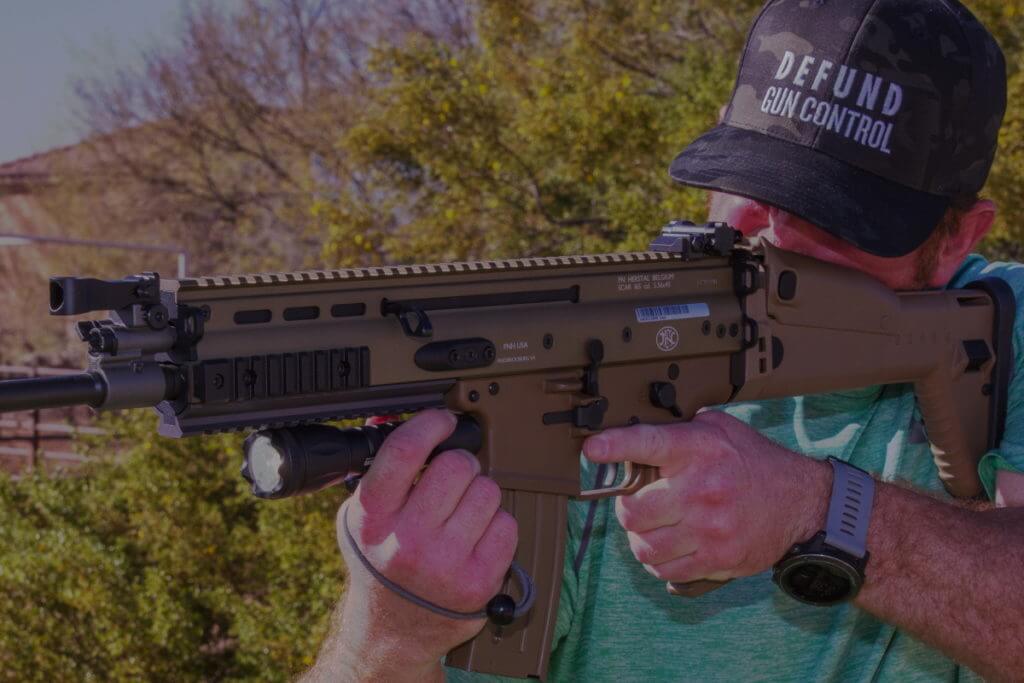
Another method is the cross support technique. The light is held as one would hold an icepick so that the switch can be pressed with the thumb of the support hand. Then the gun is cradled on the support arm.
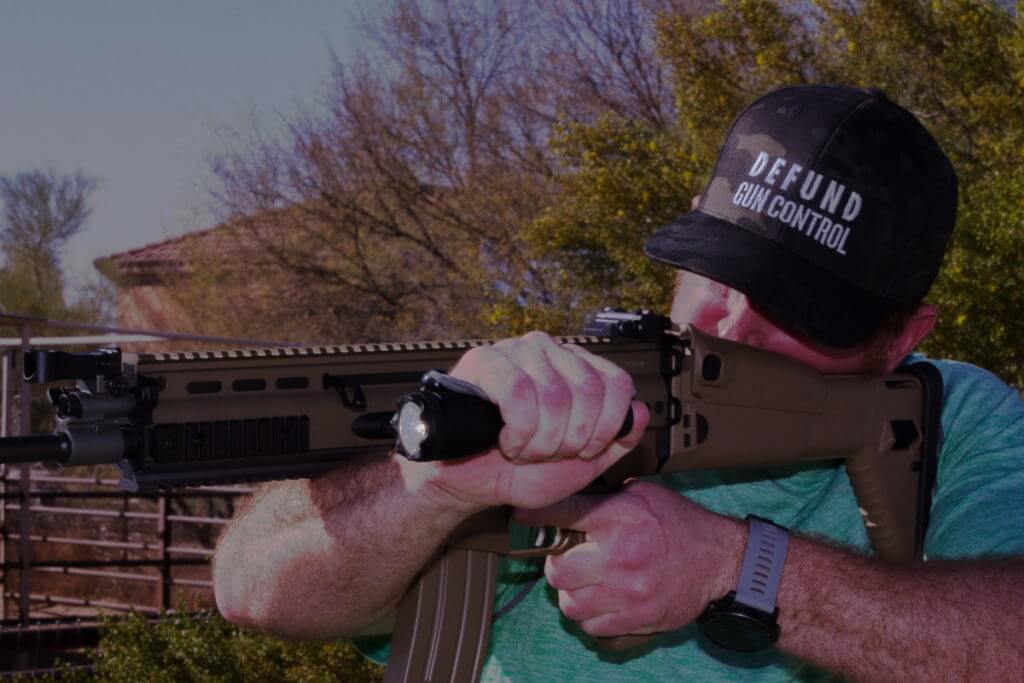
The last method to be discussed here is the modified FBI technique where the light is held in the support hand at arm’s length high and to the side of the user. The gun is then supported and fired with the other hand. It is not easy to do but is feasible with proper training. If you don’t know how to do this – shooting a long gun one-handed can be a very useful skill – you desperately need training.
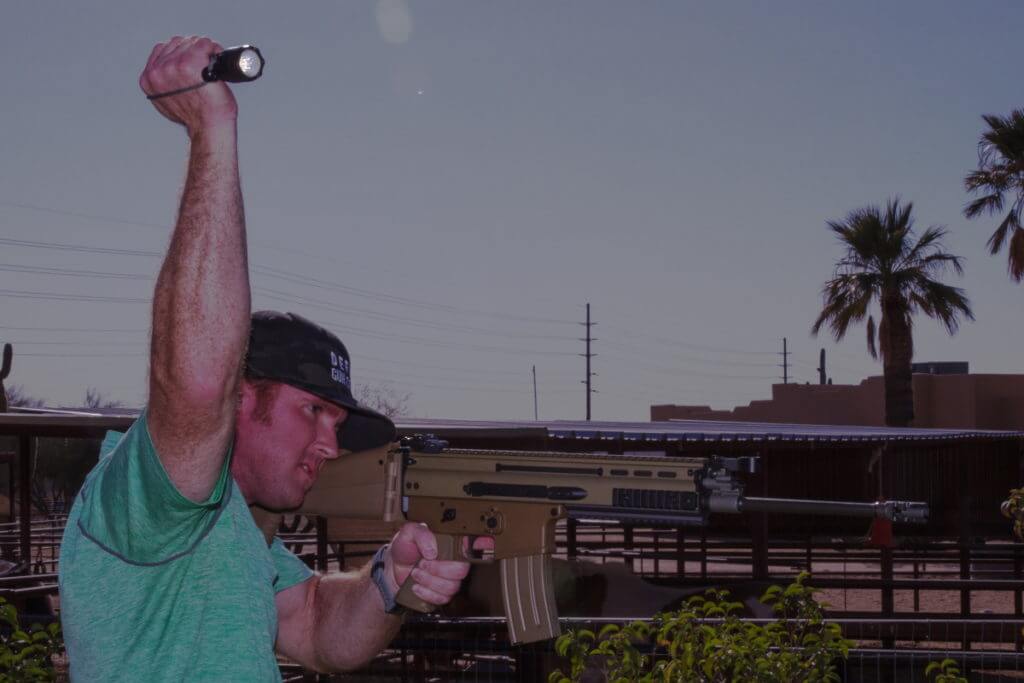
Give serious thought to what you need in a self-defense light before buying. And expect to pay plenty for it unless you want a hobby device that will not be relied on to save a life. Cheap is not usually rugged or reliable. If possible, locate a friendly seller who will let you try a light out before buying to see if the beam is what you want. But first, start with deciding what you are going to do with the light and what is needed. Again, the mission objective should dictate what equipment is needed.
And that’s the what and the why of it.
The one handed use of a long gun is reserved for last ditch, extreme close range use. Anything else is utter fantasy. The high FBI technique was developed for times past when lights had not much more lumens than a candle. The idea was the bad guys would shoot at the light and if you were holding it close to you, you’d probably get shot. With the development of high intensity, high lumen lights, the technique is to use the light as a weapon to pressure the suspect and prevent them from shooting at you by blinding them.
I use handheld and weapon mounted lights on a daily basis as a law enforcement officer and have received training from several very reputable trainers including Ken Goode, former Navy SEAL and founder of the prestigious Surefire lowlight training program and the now sadly deceased Wes Doss, among others. Most trainers who have been there and done that, agree that strobes have a very specific role in fighting at night. It is absolutely impossible to replicate the full effect of a strobe by rapidly manipulating a tail cap button and is another distraction from the decision making that should be occurring while illuminating a threat.
Before regurgitating information learned from unnamed sources from training programs, the author needs to get out and see how these techniques he advocates play out in the real world. Newsflash; while SWAT gets all the publicity, hundreds of thousands of regular patrol coppers are out every night, using handheld and weapon mounted lights to take bad guys off the streets. Some advice in this column is accurate, timely and important, (loved the comments about getting training!) but some is also nonsense.